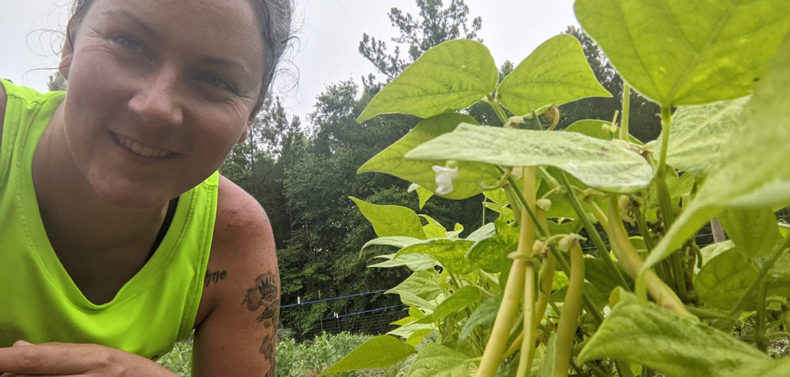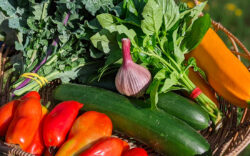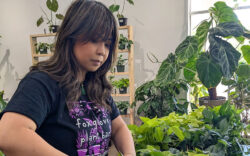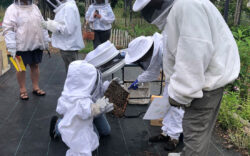Whether you’re looking at a small patio garden or a whole backyard, it’s time to harvest your produce and herbs. For new gardeners, this can cause some anxiety. When is this tomato at its most delicious? Where should I cut this parsley? Should I let this cucumber get bigger?
Besides maturity, a vegetable’s flavors also come from the soil and weather. Tomatoes harvested after a rainstorm will swell with water and taste diluted compared to the same variety harvested during a drier spell. As far as soil, there’s a reason why Vidalia onions only come from 20 counties in Georgia—the low sulfur content of the soil leads to more sweetness and less of the characteristic tear-inducing onion smell. I grew onions in my gardens this year and, whoa, I’ve got some spicy onions, weepy eyes and a new appreciation for how much soil impacts flavor.
I nibble on veggies in the garden on a daily basis. It’s a habit I picked up from my first Athens farming job. The farmers I worked for developed strong partnerships with area chefs because they knew what tasted best on a weekly and even daily basis. It’s a great habit to start if your garden is big enough to provide constant grazing.
There are some easy harvest guidelines to follow below, but there’s nothing like experience. Try tasting everything edible in your garden to know how the flavor changes as it matures and when you like it best.
Herbs: Generally harvested throughout the year, herb leaves (cilantro, parsley, sage, thyme, basil) usually taste great until they bloom. Some develop a bitter flavor, and others get much tougher while sporting flowers. This does not apply to herbs where you’re using the bloom, like chamomile.
Once your herb is established and starts growing new leaves, you can begin harvesting. With smaller herbs, you’ll want to stick to harvesting about a third of the plant at a time. Once your herb is bigger and healthier, you can harvest as much as half. The plant needs enough leaves to continue making chlorophyll, so it can eat, too.
Cut leafy herbs like cilantro, parsley and sorrel at the base of the stem. Stems remaining attached to the plant without their leaves could eventually wilt, die and create a medium for disease to attack your herb. Trimming the stems keeps the plant looking tidy as well.
Herbs that branch out, like basil, thyme and sage, should be cut close to a node or branching point. These herbs do well with frequent haircuts, so don’t be shy about harvesting. You’ll likely find that the areas you cut back most often are those that grow best.
Tomatoes: The top priority is, you’ve got to know the color of your ripe tomato. It’s usually red, but I’ve grown tomatoes that turned orange, yellow, white, green, black and striped. Let me tell you from personal experience, it can get confusing if you’ve forgotten the tomato’s final color.
Harvest when the tomato is 80–100% the correct color. If you’re worried about a pest taking a bite or a rainstorm splitting the delicate tomato skin, it’s best to harvest early and allow the tomato to ripen inside, protected. Place the tomato upside down on a paper or cloth towel and check every day for ripeness. It won’t have quite the same sun-warm flavor, but you’ll get to eat it instead of a caterpillar.
Cucumbers: Some cucumbers finish growing at 6 inches, others grow to a foot and some can reach 18 inches easily. If you’ve forgotten your variety of cucumber, you’ll want to harvest when the cucumber starts bulking up instead of growing longer. Overgrown cucumbers can get pithy or contain large, inedible seeds. Some overripe cucumbers grow a thick skin.
If you pick a cucumber late, it’s easy to peel the skin or scrape out the seeds with a spoon. Pithy cucumbers are harder to make palatable, but you can almost always harvest cucumbers small and early. You’ll miss the bulk without forgoing flavor.
Beans: Harvest green beans earlier rather than later. Don’t let these boogers get too big or they will be fibrous and bland. Beans harvested younger are sweet, tender and delicious. The easiest way to stay on top of beans is to keep harvesting them. Try for every second or third day.
If you’re looking for dried beans or edamame, you’ll want to see the seed pods fill out and then get slightly yellow or brown before harvesting. It’s always good to check inside one or two pods to see what they look like and taste like. It’s hard to wait too long on these.
Like what you just read? Support Flagpole by making a donation today. Every dollar you give helps fund our ongoing mission to provide Athens with quality, independent journalism.









